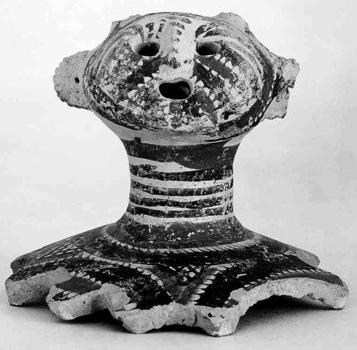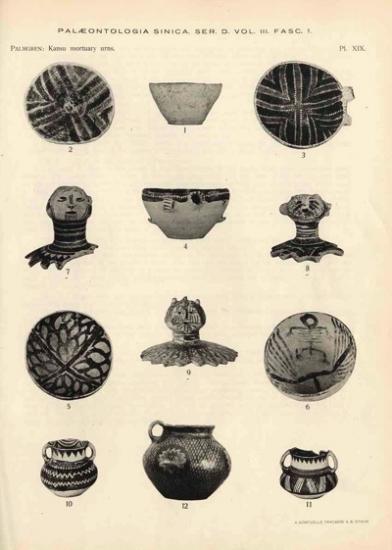The reappearance of Yangshao ? Reflections on unmourned artifacts.
Part. 1
Magnus Fiskesjö / Cornell University
Source : http://www.chinaheritagequarterly.org/scholarship.php?searchterm=023_yangshao.inc
The first excavations of Yangshao cultural remains in the 1920s inaugurated the modern discipline of archaeology in China. The recent documentary film Cutting Through the Fog of History: The Re-appearance of the Yangshao Cultural Relics[1] is one of the first Chinese attempts in many years to address the mysterious disappearance, possibly during World War II, of many of the artifacts uncovered in the course of these excavations.
In comparison with the seemingly never-ending flood of both science and fiction writings on the lost Peking Man remains, which also vanished during China's war with Japan,[2] it is curious that comparatively little attention has been given either inside or outside China to these formidable lost cultural treasures from the Neolithic era. The story of their disappearance is no less dramatic, and the lost pieces include unique cultural artifacts like the painted ceramic lid in the shape of a shaman's head, which is among the earliest human figures in East Asian art (Fig. 1, from Fiskesjö and Chen 2004,[3] pp. 148-49, and Fig. 2, from Palmgren 1934,[4] Plate XIX, cf. items 7, 8, and 9).

Fig.1 A painted ceramic lid in the shape of a shaman's head, one of the missing Yangshao artfacts. From Magnus Fiskesjö and Chen, Xingcan. China Before China: Johan Gunnar Andersson, Ding Wenjiang, and the Discovery of China's Prehistory (Bilingual, English and Chinese), Stockholm: Museum of Far Eastern Antiquities, 2004.
It is of course true that Chinese prehistoric archaeology, just like paleoanthropology and geology, has advanced considerably since the first discoveries were made, and not a few Neolithic anthropomorphic figures have emerged. But so far as I know, there are none in this intriguing style of ceramic vessel-lid shaped heads. They may be renderings of shamans, complete with tattoos, snake-hair curls, and holes to insert feathers or plumes. One possibility is that they may have served as lids for special vessels that held the shaman's utensils.
Importantly, these stunning items belong with the first group of Neolithic archaeological artifacts discovered in China, and might be expected to count as national treasures of sorts. They were obtained by the Swedish archaeologist Johan Gunnar Andersson in the course of the first modern archaeological excavations in China, in Gansu and Henan in 1921-24. These excavations were undertaken in his capacity as advisor to China's new National Geological Survey (NGS), which, together with its founders, the geology pioneers Ding Wenjiang (V.K. Ting) and Weng Wenhao (W.H. Wong), he had helped develop from the time of his arrival in China in 1914. At the time, specialized archaeological institutions did not yet exist in China, and the new scientific archaeological practice, like elsewhere, was founded on geological stratigraphy, and emerged in close institutional association with geology.
Large parts of these collections were shipped to Sweden by permission of the Chinese government. Half of these formed the basis of the Museum of Far Eastern Antiquities (MFEA) in Stockholm, which opened in 1929. The rest were returned by Andersson to Ding and Weng in seven shipments made between 1927 and 1936. These shipments included large numbers of the now-famous painted Yangshao ceramic urns, either restored or in fragmented state, and many other objects. All three shaman-heads appear to have been bought, and not excavated, two in Gansu and one in Paris from the Chinese antiquities dealer C.T. Loo.[5]
Andersson's first six shipments were made to the NGS in Beiping (now Beijing), but because the NGS was later moved to Nanjing, the last one was sent there. On his last Asian trip, in 1937-38 just before his retirement, Andersson confirmed that the shipments had arrived. A selection had been arranged as part of the permanent exhibit in the new NGS building in Nanjing, proudly shown to him by his former colleagues and students. Andersson offers a vivid description of this 1937 scene in his popular book China Fights for the World.[6] This was one of the last confirmed sightings of the objects.
After I became director of the MFEA in 2000, I learned about the history of Andersson's work, and realised that it had been forgotten. There seemed to be scant mention of his endeavours either in the Chinese or the current international archaeological or historical literature. No doubt, the reasons for this included not only the restrictions placed on Andersson's archaeological research by the World War II and the closure of China to foreign archaeologists after 1949, but also the ideological shift in the MFEA, which soon became more like other Western Asian art museums, emphasizing connoisseurship and auction-house purchases, instead of the scientific-archaeological research laboratory style that Andersson originally envisioned. Andersson himself was also by and large forgotten, even among Swedish archaeologists.[7]
When mobilizing the old collections in new MFEA exhibits, designed to highlight the peoples living in what is now China but several millennia before the idea of China itself had developed (in a 'China before China'!), I also made copies of Andersson's detailed return shipment records from 1927-36 and gave them to several Chinese authorities with a request for their help in tracing these lost treasures. The recipients included the main custodian of China's national cultural heritage, the State Administration of Cultural Heritage in Beijing (SACH, that is, the Wenwuju 文物局, a name formerly translated as the Bureau of Cultural Relics);[8] the Shanghai Museum; the Nanjing Museum; and some others. However, no-one was able to find any further clues to the whereabouts of the missing objects. The Nanjing Museum at first responded that it held a small amount of stone tools that appeared to have been discovered by Andersson, but it failed to respond to further inquiries regarding the shaman head, the hundreds of painted Yangshao urns and other outstanding artifacts returned to China by Andersson. According to rumour, this museum has a large storage closed to outsiders — either due to the traditions of secrecy and lack of public accountability that prevail in many Chinese archives, etc., or because it has not been properly organized, so that objects can only be traced with the greatest of difficulty. Having experienced the shock of discovering the awful disarray behind the scenes and the pressing need for modern collections management methods at the MFEA in Stockholm in 2000, I am very much open to the latter interpretation.
In the summer of 2005, just after my departure from Sweden, staff members at the Geological Museum of China in Beijing discovered four wooden crates at their museum which had not been opened for a very long time. They turned out to contain partially fragmented Yangshao-style Neolithic ceramics — a total of twenty-nine items, including about four whole vessels and ceramic shards, some of which had been rejoined.
As the museum's surprised geologists discovered, after some puzzlement and further inquiries, the ink annotations seen on the vessels and shards indicated that they belong with the series of objects that Johan Gunnar Andersson discovered in 1920-24. These geologists also seem to have forgotten Andersson and his close collaboration with the Chinese geologists who had launched their discipline and invited Andersson to join them. Thus the recent Chinese documentary film is in a sense also a record of the Chinese geologists' journey of self-discovery, much as we had experienced in Sweden.
While still in China, Andersson originally inscribed artifacts with the initials of the sites, such as 'Y.S.' for the Yangshao site in Henan, followed by a Roman numeral series ('VII', etc.) which referred to subdivisions of the sites. Later, he included all the artifacts in a master series created for the MFEA, which in each case starts with 'K' and is followed by an Arabic number. The lost ceramic shaman head (Fig.1) thus has the unique ID number K5473, and the shaman heads kept in Stockholm are K5472, and K11038:5 (which are items 7 and 9 in Fig.2, respectively). It remains unclear what 'K' meant, but it may stand for culture, kultur in Swedish, as opposed to the 'M' apparently often used for geological minerals and other materials. It does not, as the film suggests, stand for the Swedish term for China, 'Kina', since many other Asian materials are also listed as 'K'.

Fig.2 Some of the most famous of Andersson's artefacts, as catalogued by Nils Palmgren in 1934. See note [4].
In addition, the objects assigned for a return to Beiping were also marked 'P', and those to remain in Stockholm as 'S', both enclosed in a square, all of which was also in black ink. The 2007 film shows in close-ups how the ceramic fragments encountered in Beijing's Geological Museum of China were annotated both 'Y.S.' and 'C.C.P.' (Ch'i Chia P'ing, or Qijiaping, in Gansu, another of the many sites Andersson discovered), etc. — but also belonged to the 'K' series (K11242:63; K11032:7, etc.). Out of the twenty-nine items, nine were marked 'P', one worn painted-ceramic shard marked K11038:7 was also marked 'S', and four nearly complete vessels lacked either 'P' or 'S'. These materials surely belong with those discovered in 1920-24 and taken to Beijing by Andersson and his Chinese colleagues, but it remains unclear whether they have all been to Sweden and back, or not. The film cites just one item from the boxes discovered in 2005, namely K6371, as listed by Andersson in his return lists (for the shipment leaving for 'Peip'ing' [Beiping/Beijing] on July 4, 1932). Apparently the museum has not checked all the numbers against the complete lists, but only against the published sample page in our book, mentioned above [Fig.2]. Perhaps the twenty-nine items were indeed returned from Sweden, but accidentally excluded from those taken to Nanjing with the many hundreds of other items appropriated by the NGS. One wonders if more such items may be found in Beijing.
part. 2